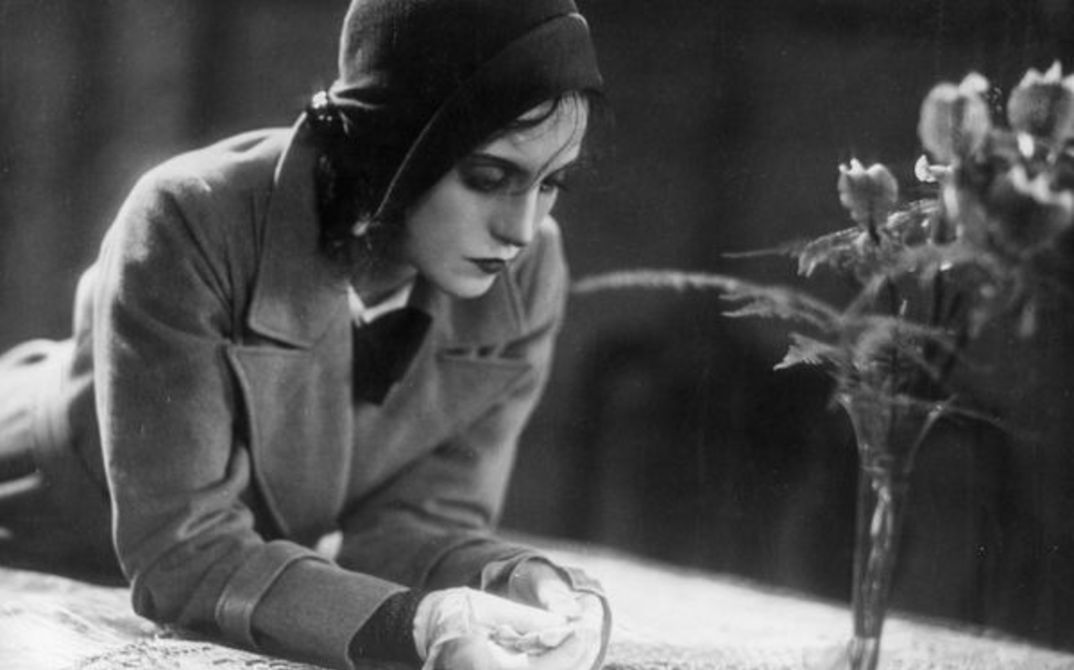This year’s edition of the film heritage festival “Film:ReStored” is dedicated to film sound. Examples from sonic film history stemming from gramophone records to four-channel magnetic sound as well as digital technologies that seek to come as close as possible to original noises are to be presented. Films that survive in different sound versions also represent a sound-related problem at a different level. One example here are Hans Richter’s experimental silent films from the 20s, for which he also created soundtracks later on. Audio descriptions for the visually impaired are a special kind of soundtrack and are increasingly often available for historical films too. Examples of successful audio descriptions will be presented and can be experienced by the audience.
ARIANE (Paul Czinner, Germany 1931, 24.10.) In this romantic chamber drama, Elisabeth Bergner plays the young Ariane, who pretends to be an experienced woman of the world to attract the interest of the much older playboy Konstantin Michael. Numerous misunderstandings and disappointments must be overcome before the two of them can declare their love for one another, free from all pretenses.
DWIE JOASIE (Myeczyslaw Krawicz, Poland 1935, 26.10.) The focus here is also on seduction under the mantel of disguise. Protagonist Joasia shifts between her roles as a demure secretary and celebrated ballroom queen to win the heart of her boss. The comedy is a rare example of popular cinema in pre-war Poland, as nearly all prints from that era were destroyed in the war.
DIE JAGD NACH DER MILLION (Max Obal, Germany 1930, 25.10.) was initially shot as a silent film. The Aafa film production then had music and sound recorded on gramophone records, which were then played during the screenings. The sensational film features famous acrobat of the time Luciano Albertini in the role of a count whose identity is stolen and stumbles across a conspiracy to land a huge inheritance. It can be now be seen for the first time with restored sound sequences.
DER FLIEGENDE HOLLÄNDER (East Germany 1964, 26.10.) In 1964, the DEFA feature film studio commissioned Joachim Herz to adapt Richard Wagner’s opera “Der fliegende Holländer”. In widescreen and with the best sound quality, this work for the stage was supposed to become a visual and sonic big screen event. Shot with four-channel magnetic sound, whose four tracks were an early forerunner of surround sound, the film still captivates today thanks to its unconventional adaptation, which adds a realistic framing narrative to the saga and expresses the shifts between dream sequences and reality via different aspect ratios.
MACH DIE MUSIK LEISER (Germany 1994, 24.10.) Thomas Arslan’s feature debut, which makes use of non-professional actors, is an example of less large-scale and much more recent production whose digitization still requires care. Music plays a major role in the directionless lives of a group of adolescents, with an impressive soundtrack to form a suitable undertone to the anxious stasis they find themselves in.
DASS EIN GUTES DEUTSCHLAND BLÜHE (Joop Huisken, East Germany 1959, 26.10.) is an example of a spoken text being reworked for ideological purposes. For this image film shot for the 10th anniversary of East Germany, poet Stephan Hermlin was commissioned to write the commentary and speak it. His more poetic than heroic language created dissent among the party leadership when the film was delivered and a new text was then commissioned from Karl-Eduard von Schnitzler.
GIGANT BERLIN (Leo de Laforgue, West Germany 1964, 25.10.) was made with the support of the Berlin Senate. For this documentary shot during the construction of the Berlin Wall between 1961 and 1963, the director took his bearings from Walter Ruttman’s "Berlin – Die Sinfonie der Großstadt". In the process, he created a portrait of Berlin that captures the city’s contradictions in unique fashion.
TON/FILM/EXPERIMENT (26.10.) This short film program curated by sound designer Dirk Schaefer makes clear which role the soundtrack plays for the visual experience. Examples from the history of avant-garde cinema demonstrate different approaches to film sound and thus give a summary of the diversity of auditory elements. Experiments with visualizing the soundtrack will be presented as well as sound design that makes use of both analogue and digital technologies.
DIE REISE NACH SUNDEVIT (Heiner Carow, East Germany 1966, 27.10.) follows a young runaway on his trip to the Baltic Sea coast in black-and-white images drenched in sunlight. The audio description is designed for young audiences, who were the target group for this family film.
JEDER FÜR SICH UND GOTT GEGEN ALLE (The Enigma of Kaspar Hauser, Werner Herzog, West Germany 1974, 27.10.) is to a certain extent the story of a failed attempted at reintroduction to society: having grown up far away from people, Kaspar Hauser may learn how to speak, read, and make music, but remains an outsider, as he cannot adapt to society’s expectations. The audio description written and spoken by Norbert Lill captures the lyricism and symbolic power of the images in harmonious fashion.
ZWISCHENZEIT (Wendländische Filmkooperative, West Germany 1985, 27.10.) doesn’t just shift between fictional and documentary elements, but also lives from a range of different references. A fictitious acceptance researcher comes to Wendland to carry out research there on the movement against atomic energy. Via the ironic distance created by the character of the pseudo-sociologist, a sharp-witted portrayal of the battle over the nuclear waste processing plant in Gorleben comes into focus. It’s not just the digital version of ZWISCHENZEIT that receives its premiere here, but also the audio description specially created for the restoration.
ES GESCHAH AM HELLICHTEN TAG (Ladislao Vajda, CH/BRD/E 1958, 27.10.) This crime thriller starring the great Gert Fröbe and Heinz Rühmann revolves around a child murderer who is supposed to be caught by using a young girl as bait and is based on the story by Friedrich Dürrenmatt. The 4K digitized version can be experienced with audio description in the cinema for the very first time. (ah)
More information and registration at filmrestored@deutsche-kinemathek.de



